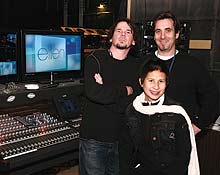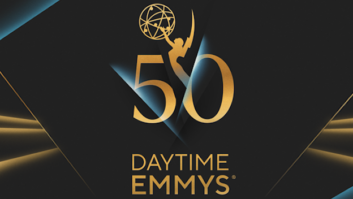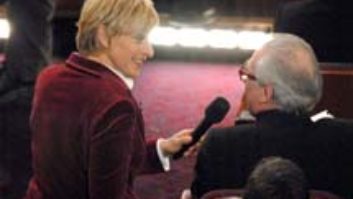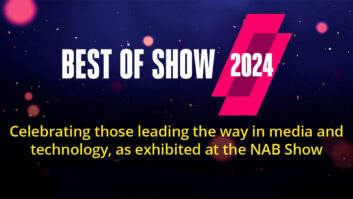
P.A. mixer Neil Taylor (standing, left) and audio assistants Ron Thompson and Liza Tan
Photos by Michael Rozman/Warner Bros.
Talk about working “in the trenches.” Consider the challenges of putting together a daily one-hour television talk/variety show, five programs a week, 170 a year. The Ellen DeGeneres Show has been one of the most popular daily programs in syndication since it debuted in 2003 — and its sound crew one of the most honored: For five years running (2003-2008), it has won the Daytime Emmy for mixing, or, as the category is technically known, “Outstanding Achievement in Live and Direct to Tape Sound Mixing.” (The show has also earned more than 20 non-sound Emmys for DeGeneres herself, direction, etc.) And the program looks and sounds better now than ever before: This season, the show moved to new digs at Warner Bros. Studios in Burbank, Calif., and it’s now shot in HD, delivered in both stereo and 5.1, and completely tapeless. Helming the audio for Ellen is production sound mixer Terry Fountain (who has been with the show since its inception) and playback mixer Dirk Sciarrotta (on the show for the past three seasons).
A show like this probably looks like a relatively easy sound job — people sitting in chairs and talking, right? Wrong! Watch the show closely and you’ll see that the whole studio is in sonic play, from the always active and participatory audience of more than 300 who attend every taping, to different parts of the soundstage where all manner of funny (and often strange) games and activities take place on a given show (sometimes preplanned, sometimes not), to the area where, on nearly every program, a top musical artist performs. Even a backstage bathroom is not off-limits: It’s where DeGeneres’ “Bathroom Concert Series” takes place — the host and a guest(s) sing together in the loo for a couple of minutes; it’s odd, but also charming and cool — just like DeGeneres herself.

Playback mixer Dirk Sciarrotta
Before this season, Ellen was shot on Stage 11 at NBC Studios in L.A. Fountain designed and assembled the control room, and front-of-house and monitor systems there from scratch. That control room had a Yamaha M3000a 56-input console (36 inputs for bands, 20 for production) and a 24-channel M3000 aux console, while the FOH board was a Mackie 32 8-bus, with two expander consoles. Then and now he monitored primarily on Mackie HR824s. The show was recorded on DigiBeta and edited on Avid.
In the new, larger Warner studio, Fountain sits behind a gleaming Studer Vista 8 digital live production console, while Sciarrotta has a position directly behind him, dominated by a CueLogic SpotOn real-time audio playback system. Fountain says, “When we first started, I had a PC with Cool Edit Pro and a 360 Systems Instant Replay. When Dirk started in season 4, though, I upgraded to the SpotOn system.”
“Back at NBC, I was positioned in a far corner of the audio room actually behind Terry’s right near-field speaker,” Sciarrotta notes. “It was a tight fit with all the gear, and I had no visual of Terry or the control room. There was no network file sharing, and I only had a 4-channel PL [private line/intercom] station. My desk was an analog Mackie Onyx, and SpotOn was analog to Terry. Now I have a proper position behind Terry, room for gear and expansion, all the network file-sharing capabilities, HDMI split-screen with all the cameras, a PL station with anything I need, prompter, routers, full digital routing from SpotOn to Terry’s Studer via a Yamaha 01V, a great view of the control room — and it looks good, too!”
CueLogic is an L.A.-based company started three years ago by Sciarrotta — who in addition to serving as playback mixer for Ellen has worked on The Price Is Right, Family Feud, various awards shows and more — and Tom Evans, who has designed and built various computer-based technical systems (and works as playback mixer for The Late, Late Show With Craig Ferguson). It was Evans who found SpotOn, a software application written by David Markie, and working with Sciarrotta figured out a way to integrate it as the centerpiece of a broadcast playback environment.
“The system allows me to play multiple cues out of multiple outputs in multiple colors,” Sciarrotta explains. “They are triggered by a touchscreen and the cues look like buttons. These buttons can be moved around, outputs can be changed per button, levels can be adjusted, text can be changed, the size of the buttons can be adjusted, multiple file types can be played and there are many more features. I can trigger one cue and have that cue trigger others. I can set fade-ins and -outs, group cues together, edit head and tail points, and so on.

Lily Allen and DeGeneres perform as part of the “Bathroom Concert Series.”
“The best part is that it is all located in one box. That box is a computer, and since you are already in a computer, you can choose whatever editing software you like. I use Adobe Audition as my main 2-channel and multitrack editor. The music and SFX are all in there, so dragging and dropping is a simple task.”
The Ellen DeGeneres Show usually shoots four days a week — single shows Monday through Wednesday and two shows on Thursday — and there’s typically just a one-day lag between when a program is shot and when it airs (except for the second Thursday show). Even so, it’s shot in real time — which is to say, in an hour — beginning at 4 p.m.
Of course the day begins much earlier for the audio team. “A typical day starts with a production meeting at 9:30 a.m.,” Fountain says. “Using the show rundown, the producers and staff go through the show segment by segment.”
“We come to work daily with a blank canvas of a show in front of us,” Sciarrotta adds. “I get the preliminary rundown for the show that day and I pre-build whatever music, SFX or voice-over cues I need within SpotOn. After I am pre-built, I contact various writers and producers and continually update, change and create cues throughout the day. The most common event for me is acquiring a popular music cut, editing it for playback and loading it into SpotOn.
“As the day goes on, updating of the show elements continues as the writers and producers decide what works and what doesn’t: Change this music, or make that SFX shorter, or pick a new edit point — those are all common things that we deal with each day. Timing might change and kinks are worked out. Sometimes it’s fine just the way we rehearsed. Sometimes it’s not.”

Stevie Wonder visits Ellen.
The bulk of the show is unrehearsed except, of course, for the soundchecks for the musical performers. The Ellen show has become a “must” stop for acts plugging their new albums, and over the years has presented an incredible array of bands and singers, including such “names” as Stevie Wonder, Paul McCartney, Prince, Elton John, Madonna, Christina Aguilera, Usher, Kanye West, Earth Wind & Fire, Garth Brooks and Mariah Carey, as well as scores of mid-level and up-and-coming acts. Over the course of the month or so when we were preparing this story, musical guests included Wonder, Lily Allen, the Jonas Brothers, The Bird and The Bee, Fall Out Boy, Matt Nathanson, The Fray and Raphael Saadiq; lots of variety, and it always sounds good.
Fountain says he feels right at home mixing the bands for broadcast: “I worked for Showco back in the ’70s and I mixed countless concerts. I was on the road for six years and I did front of house for George Benson for the last two years on the road. I started doing TV sound at ABC in the mid-’80s — everything from Lawrence Welk to American Bandstand. When I started mixing music on TV, I felt like it should sound like a concert instead of a TV show, and this is my approach.
“When I get to the music part of the show, I want to feel like I am mixing on a large P.A. system, so I turn it up a few dB. I find that when I listen a little loud — some would say really loud — it makes my program mix record just under the point where the affiliates’ compressor/limiter might affect the mix. So when you watch at home and listen on your TV speakers or your surround system, you can turn it up and that concert feel is there for you quite nicely. My wife, Kim, always says, ‘Nice drum mix!’

Production sound mixer Terry Fountain
“The show is busy, so the soundcheck part of the day is quite limited. I mix both the production and the bands, so I have to have a handle on all of the sounds of all the instruments before the band even walks onstage. It’s rare that I get 30 minutes with the band before we camera block. Sometimes we only get one pass on camera before we have to move on to rehearse something else, so that six years of working quickly [on the road] has paid off.”
About half the time, Fountain says, the band will have someone in the booth with him during the soundcheck and live mix, which “usually helps keep me from missing something particular to the mix that I might not be aware of,” he says. “Other times I think it’s better to just go solo because it brings another sound to the music mix that they may not have experienced.”
How many inputs would a typical performance require? “I have 40 inputs set aside for band inputs, which is usually overkill,” Fountain says. “We had Stevie Wonder on a couple of weeks ago and we had to pare it down to 40 inputs from 100 inputs. Stevie has been on a couple of times and he doesn’t bring anyone with him to sit with me, but we all know how Stevie should sound.
“All of our mics are from my collection. I’m a big fan of Shure mics and use them a lot, but I have a lot of Sennheiser mics, and a variety of direct boxes for keyboards, as well.”
Neil Taylor (who has been with the show since the beginning) handles the music mix for the studio audience on a pair of Yamaha MC7L digital mixers; music monitoring is done by Eric Slaughter and John Perez on a Yamaha PM5D.
As for miking the main part of the show and the other conceptual segments, Fountain eschews traditional studio booms, and notes, “The size of the stage makes it hard to wire anything with cable except the bands. So we use Soundtronics wireless systems to gather audio from the various sources around the stage. We use Sennheiser 5212 wireless packs with Sennheiser Platinum lav mics for Ellen and the people she interviews.”
However, he adds, “Surprises happen all the time, and we don’t always put a mic on everyone. So my floor A2s [assistants] — Liza Tan and Ron Thompson, who’ve been with me from the start — have wireless fishpoles with shotgun mics on them for these moments. For instance, before the show, the audience dances to music that we play for them, and Ellen watches this in her dressing room as she gets ready. Later, during the show Ellen may want to replay a clip of a dancer she likes and talk to them in the audience. When this happens, our floor A2s need to be ready to pick up this audio with a fishpole and shotgun mic.”
As for the Bathroom Concert Series, it’s “a single mic in the bathroom,” Sciarrotta reveals. “The music is played from a boom box. They bring me a karaoke version of the song they want to do, then I edit it to an in-point of their liking. After that, I simply burn the cut onto a CD, which is played from a boom box in the bathroom. I also have the cut standing by in SpotOn, ready to play back at any time through a Fostex speaker set up in there, just in case they need it.” Both Lily Allen and two members of Fall Out Boy joined DeGeneres (on separate shows) to sing versions of Britney Spears’ “Womanizer” (of all things), while Pink and DeGeneres struggled through a hilarious version of Pink’s “So What,” and Bret Michaels led 10 female fans (a tight squeeze) through Poison’s “Every Rose Has Its Thorns.” (The show also has encouraged viewers to send in their own Bathroom Concert songs and has shown some.)
Over the course of the day, Fountain says, “Dirk and I communicate constantly and coordinate our respective responsibilities. I have three stereo feeds from Dirk — announce, SFX and music. There are many different cues, depending on whether we are doing a game, a remote, telephone call, you name it.”
Sciarrotta adds, “We collaborate on the cues — their levels, the in and out points, and the outputs that each of the cues is played on. For example, there may be an underscore creating tension, and then on top of that there will be stings. I will play the music pair to Terry, he will know to keep it as an underscore, and I will fire stings down the SFX outputs so they can stay on top of the music. This makes it easy for Terry to separate the two streams, and makes it easier for me to hit the cues and keep the stings prominent.”
During the show, “We constantly listen to our director, Liz Patrick, as things change moment to moment,” Fountain says. “The assistant director, John Zook, is also very important because he counts every second of the show as it happens, and these timings are my lifeline for the many audio transitions that I do live.”
“We need to be ready for basically everything,” Sciarrotta offers. “Surprises happen every day. The show is never the same twice. You never know what is actually going to happen at any moment. While Ellen is conducting an interview, the person being interviewed might mention their favorite song. At that moment, I am fishing for that cut of music and loading it into SpotOn for playback by the end of the segment or whenever someone calls for it. Get it ready and get it fast, because you just don’t know. I would say 90 percent of the show is unrehearsed.
“At the end of the night, we have to make sure post-production does not need anything from us. If there was a music cue that was not timed right or was up-cut, I have access to shared folders that I can simply drop music into for the editors. Our post-production needs can also include SFX for a tape piece or VOs we record. The shared folder system works well; no need to burn CDs anymore. As we prepare for a taping during the day, I also have access to shared folders with producers in our production offices. They can drop music in my folder so I can use it for whenever I need it. This saves a lot of time and avoids having to burn a CD. I simply drag and drop.”
In general, Fountain notes, “The show is not ‘sweetened’ per se. Ninety-nine percent of what you hear at home is what I mixed live, including the bands. I very rarely change a music mix; when I do need to remix a song, I use a Fairlight multitrack audio/video recorder. It’s saved my life a few times!”
As for the surround broadcast, “The 5.1 is created via an upmix so that if anything is changed after the fact, it doesn’t change the 5.1 mix,” Fountain says. “It simply is edited in stereo and upmixed for broadcast.”
Given the hectic pace, it’s amazing more things don’t go wrong on shows like these. But that danger is part of what makes working on what is essentially live television so exciting. “The biggest challenge has to be that the show is mostly impromptu,” Fountain says. “You really have to have game to mix a show like this.”





